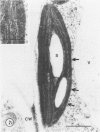Abstract
Shoots of 16-day-old soybeans (Glycine max L. Merr. cv Ransom) were chilled to 10°C for 7 days and monitored for visible signs of damage, ultrastructural changes, perturbations in fluorescence of chlorophyll (Chl), and quantitative changes in Chl a and b and associated pigments. Precautions were taken to prevent the confounding effects of water stress. A technique for the separation of lutein and zeaxanthin was developed utilizing a step gradient with the high performance liquid chromatograph. Visible losses in Chl were detectable within the first day of chilling, and regreening did not occur until the shoots were returned to 25°C. Ultrastructurally, unstacking of chloroplast grana occurred, and the envelope membranes developed protrusions. Furthermore, the lipids were altered to the point that the membranes were poorly stabilized by a glutaraldehyde/osmium double-fixation procedure. Chl fluorescence rates were greatly reduced within 2 hours after chilling began and returned to normal only after rewarming. The rapid loss of Chl that occurred during chilling was accompanied by the appearance of zeaxanthin and a decline in violaxanthin. Apparently a zeaxanthin-violaxanthin epoxidation/de-epoxidation cycle was operating. When only the roots were chilled, no substantial changes were detected in ultrastructure, fluorescence rates, or pigment levels.
Full text
PDF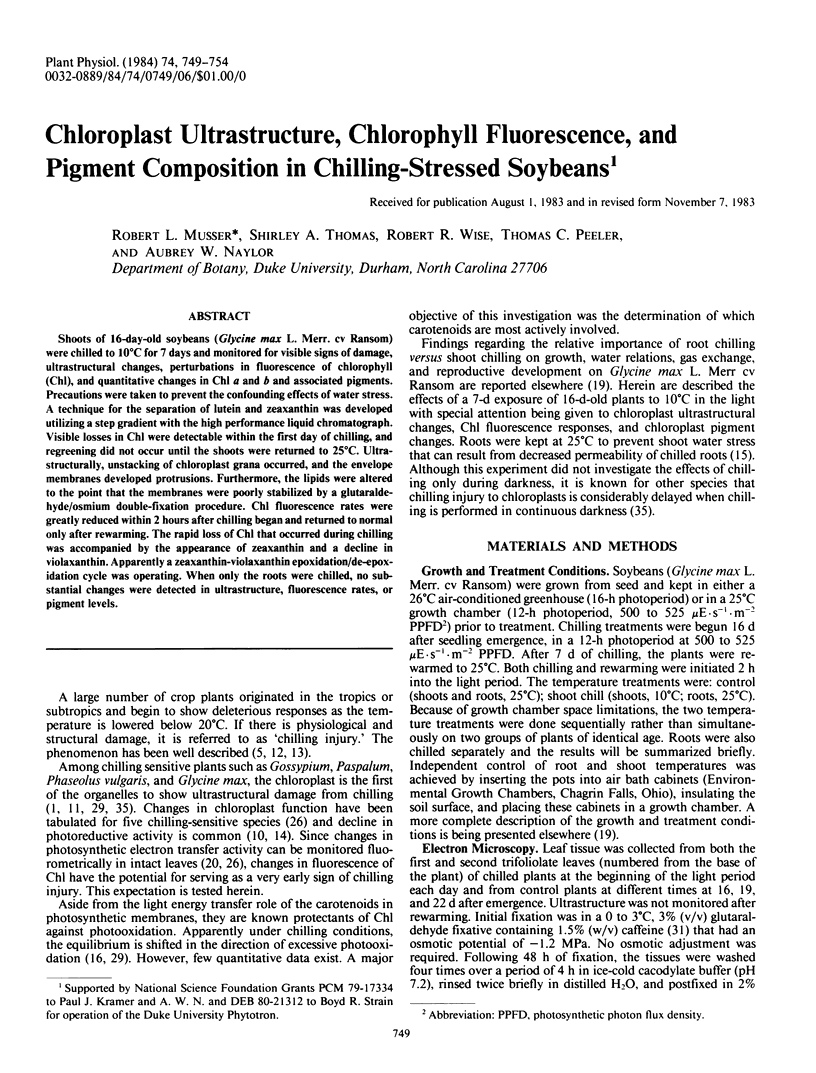
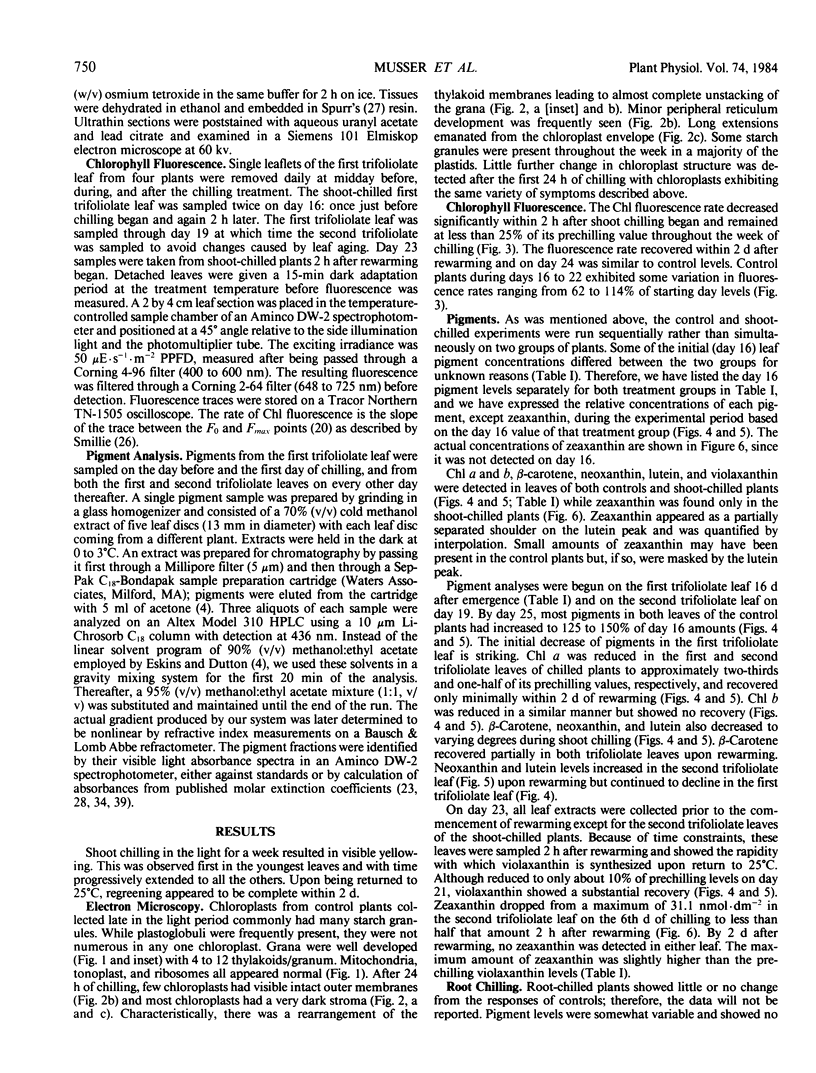
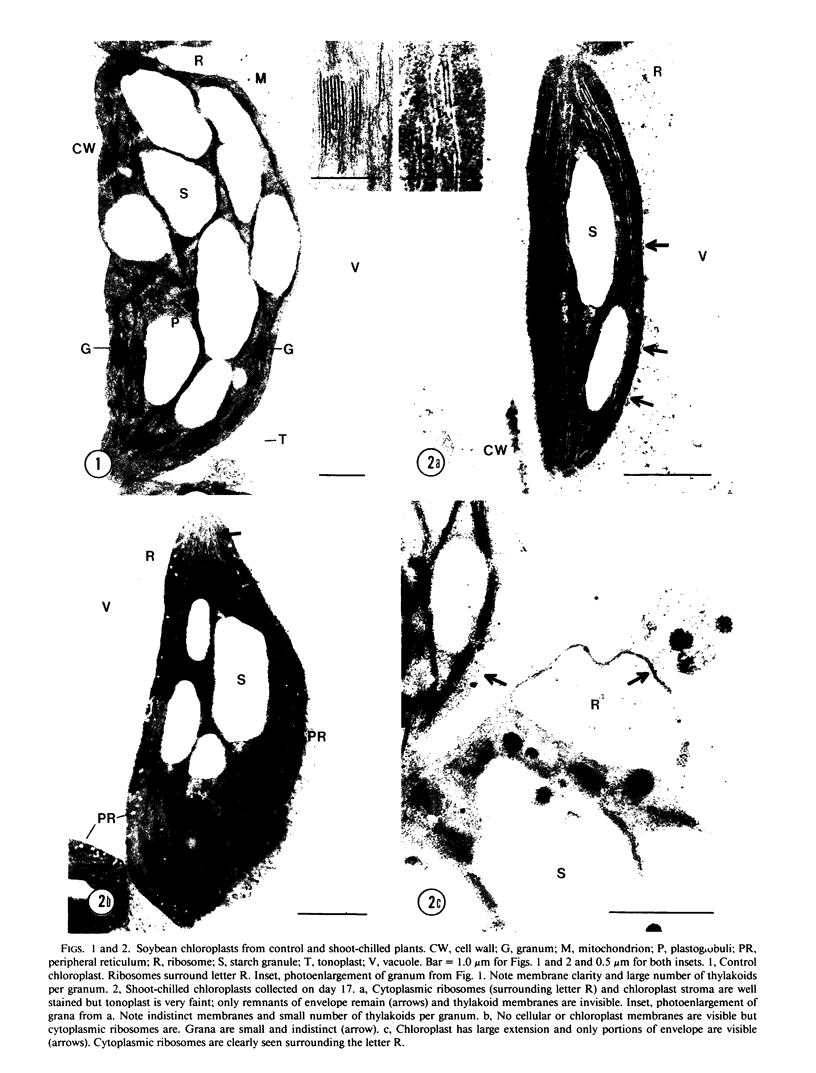
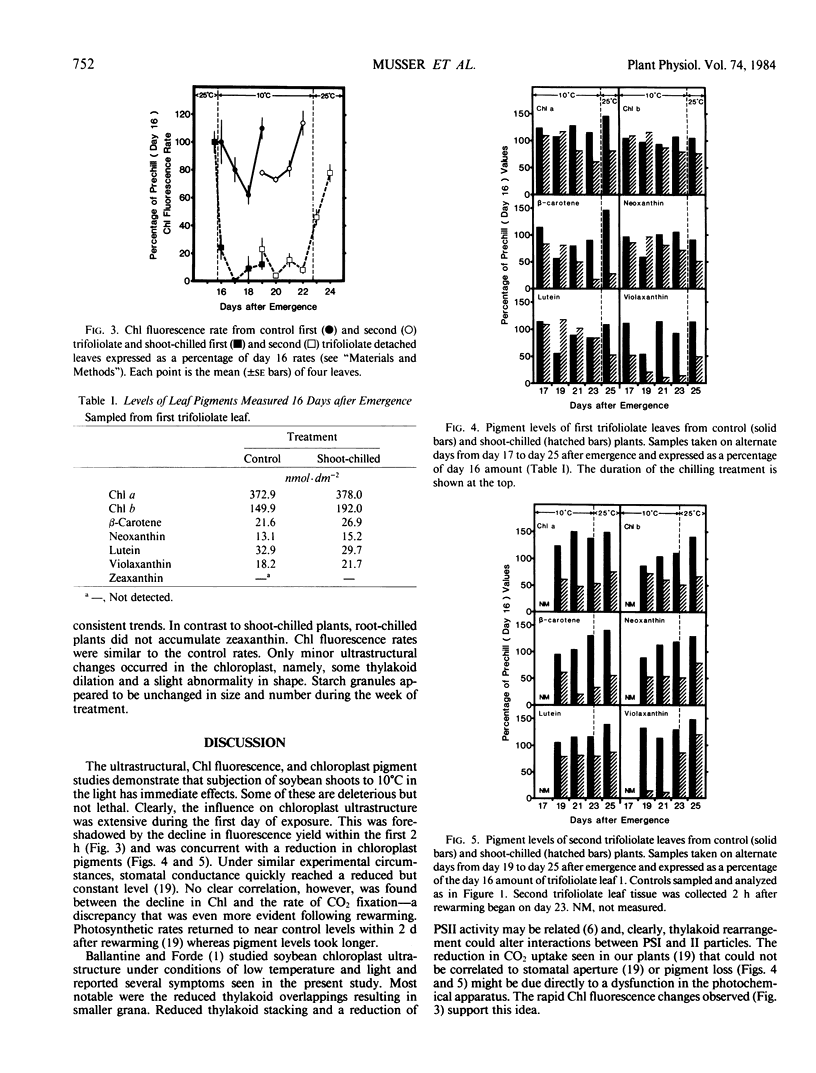
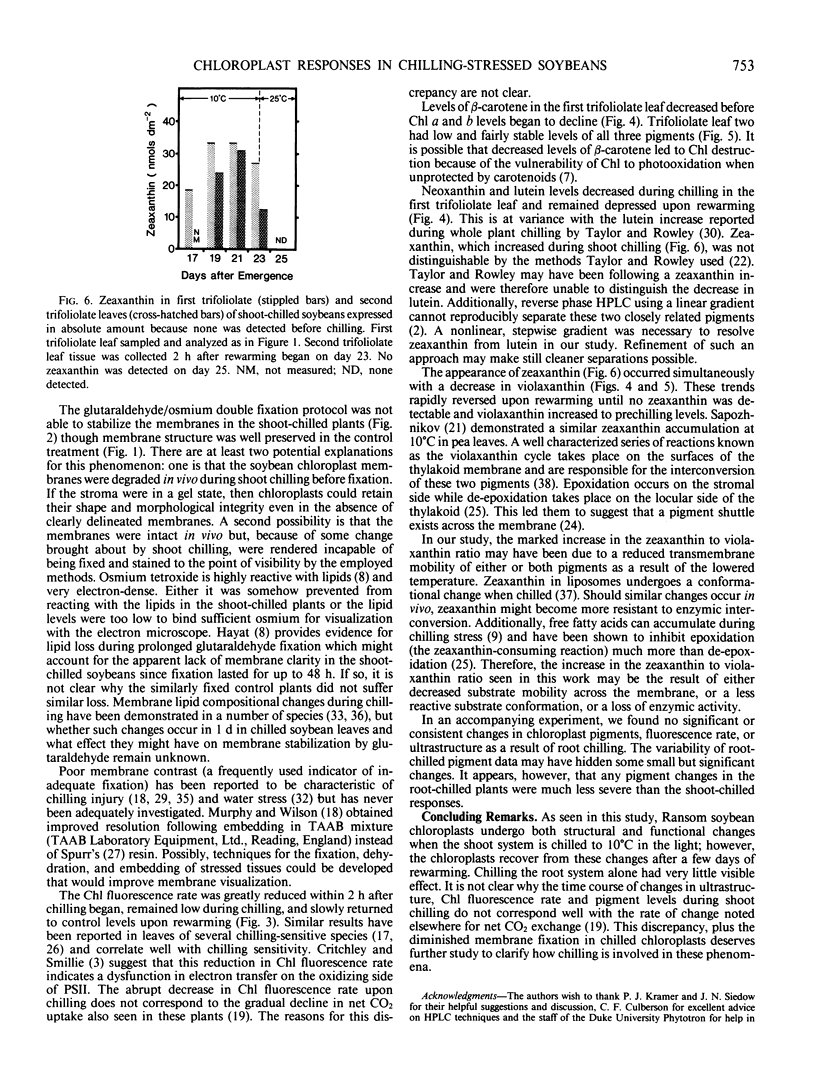
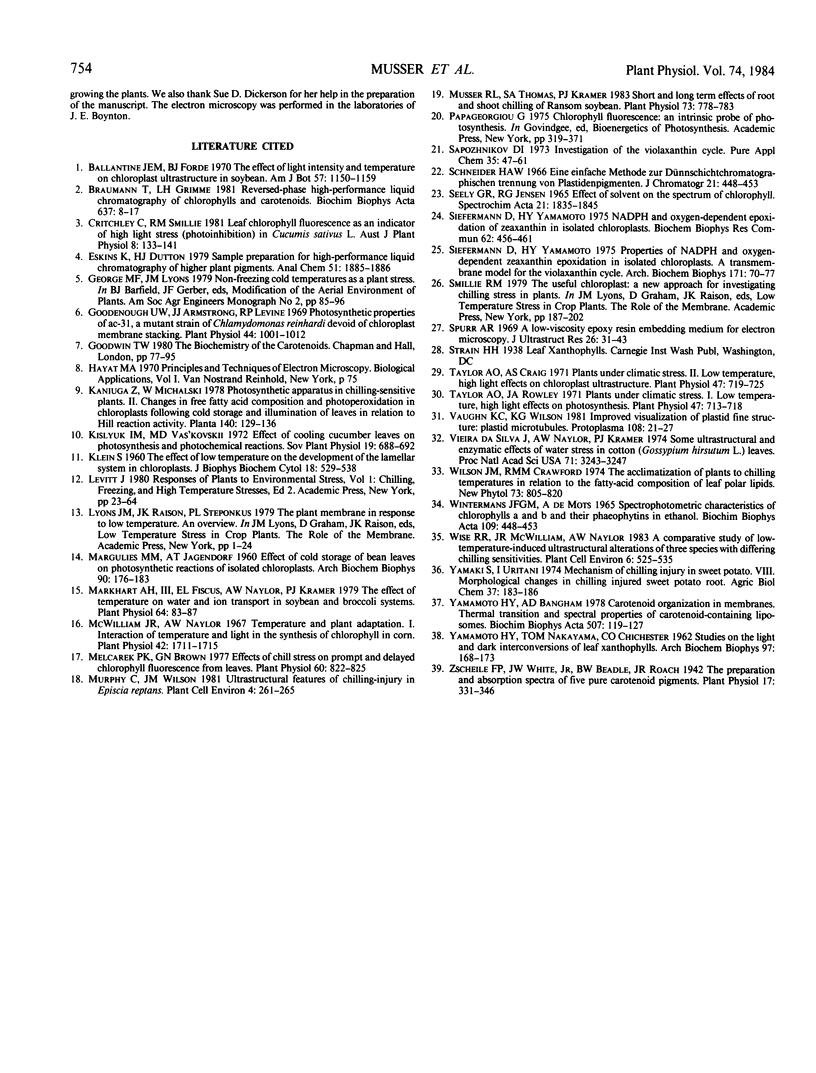
Images in this article
Selected References
These references are in PubMed. This may not be the complete list of references from this article.
- Da Silva J. V., Naylor A. W., Kramer P. J. Some ultrastructural and enzymatic effects of water stress in cotton (gossypium hirsutum L.) leaves. Proc Natl Acad Sci U S A. 1974 Aug;71(8):3243–3247. doi: 10.1073/pnas.71.8.3243. [DOI] [PMC free article] [PubMed] [Google Scholar]
- Goodenough U. W., Armstrong J. J., Levine R. P. Photosynthetic Properties of ac-31, a Mutant Strain of Chlamydomonas reinhardi Devoid of Chloroplast Membrane Stacking. Plant Physiol. 1969 Jul;44(7):1001–1012. doi: 10.1104/pp.44.7.1001. [DOI] [PMC free article] [PubMed] [Google Scholar]
- KLEIN S. The effect of low temperature on the development of the lamellar system in chloroplasts. J Biophys Biochem Cytol. 1960 Oct;8:529–538. doi: 10.1083/jcb.8.2.529. [DOI] [PMC free article] [PubMed] [Google Scholar]
- MARGULIES M. M., JAGENDORF A. T. Effect of cold storage of bean leaves on photosynthetic reactions of isolated chloroplasts. Arch Biochem Biophys. 1960 Oct;90:176–183. doi: 10.1016/0003-9861(60)90565-8. [DOI] [PubMed] [Google Scholar]
- Markhart A. H., Fiscus E. L., Naylor A. W., Kramer P. J. Effect of temperature on water and ion transport in soybean and broccoli systems. Plant Physiol. 1979 Jul;64(1):83–87. doi: 10.1104/pp.64.1.83. [DOI] [PMC free article] [PubMed] [Google Scholar]
- McWilliam J. R., Naylor A. W. Temperature and plant adaptation. I. Interaction of temperature and light in the synthesis of chlorophyll in corn. Plant Physiol. 1967 Dec;42(12):1711–1715. doi: 10.1104/pp.42.12.1711. [DOI] [PMC free article] [PubMed] [Google Scholar]
- Melcarek P. K., Brown G. N. Effects of chill stress on prompt and delayed chlorophyll fluorescence from leaves. Plant Physiol. 1977 Dec;60(6):822–825. doi: 10.1104/pp.60.6.822. [DOI] [PMC free article] [PubMed] [Google Scholar]
- Musser R. L., Thomas S. A., Kramer P. J. Short and long term effects of root and shoot chilling of ransom soybean. Plant Physiol. 1983 Nov;73(3):778–783. doi: 10.1104/pp.73.3.778. [DOI] [PMC free article] [PubMed] [Google Scholar]
- Sapozhnikov D. I. Investigation on the violaxanthin cycle. Pure Appl Chem. 1973;35(1):47–61. doi: 10.1351/pac197335010047. [DOI] [PubMed] [Google Scholar]
- Schneider H. A. Eine einfache Methode zur dünnschichtchromatographischen Trennung von Plastidenpigmenten. J Chromatogr. 1966 Mar;21(3):448–453. doi: 10.1016/s0021-9673(01)91339-1. [DOI] [PubMed] [Google Scholar]
- Siefermann D., Yamamoto H. Y. NADPH and oxygen-dependent epoxidation of zeaxanthin in isolated chloroplasts. Biochem Biophys Res Commun. 1975 Jan 20;62(2):456–461. doi: 10.1016/s0006-291x(75)80160-4. [DOI] [PubMed] [Google Scholar]
- Siefermann D., Yamamoto H. Y. Properties of NADPH and oxygen-dependent zeaxanthin epoxidation in isolated chloroplasts. A transmembrane model for the violaxanthin cycle. Arch Biochem Biophys. 1975 Nov;171(1):70–77. doi: 10.1016/0003-9861(75)90008-9. [DOI] [PubMed] [Google Scholar]
- Taylor A. O., Craig A. S. Plants under Climatic Stress: II. Low Temperature, High Light Effects on Chloroplast Ultrastructure. Plant Physiol. 1971 May;47(5):719–725. doi: 10.1104/pp.47.5.719. [DOI] [PMC free article] [PubMed] [Google Scholar]
- Taylor A. O., Rowley J. A. Plants under Climatic Stress: I. Low Temperature, High Light Effects on Photosynthesis. Plant Physiol. 1971 May;47(5):713–718. doi: 10.1104/pp.47.5.713. [DOI] [PMC free article] [PubMed] [Google Scholar]
- Wintermans J. F., de Mots A. Spectrophotometric characteristics of chlorophylls a and b and their pheophytins in ethanol. Biochim Biophys Acta. 1965 Nov 29;109(2):448–453. doi: 10.1016/0926-6585(65)90170-6. [DOI] [PubMed] [Google Scholar]
- YAMAMOTO H. Y., NAKAYAMA T. O., CHICHESTER C. O. Studies on the light and dark interconversions of leaf xanthophylls. Arch Biochem Biophys. 1962 Apr;97:168–173. doi: 10.1016/0003-9861(62)90060-7. [DOI] [PubMed] [Google Scholar]
- Yamamoto H. Y., Bangham A. D. Carotenoid organization in membranes. Thermal transition and spectral properties of carotenoid-containing liposomes. Biochim Biophys Acta. 1978 Feb 2;507(1):119–127. doi: 10.1016/0005-2736(78)90379-6. [DOI] [PubMed] [Google Scholar]
- Zscheile F. P., White J. W., Beadle B. W., Roach J. R. THE PREPARATION AND ABSORPTION SPECTRA OF FIVE PURE CAROTENOID PIGMENTS. Plant Physiol. 1942 Jul;17(3):331–346. doi: 10.1104/pp.17.3.331. [DOI] [PMC free article] [PubMed] [Google Scholar]




